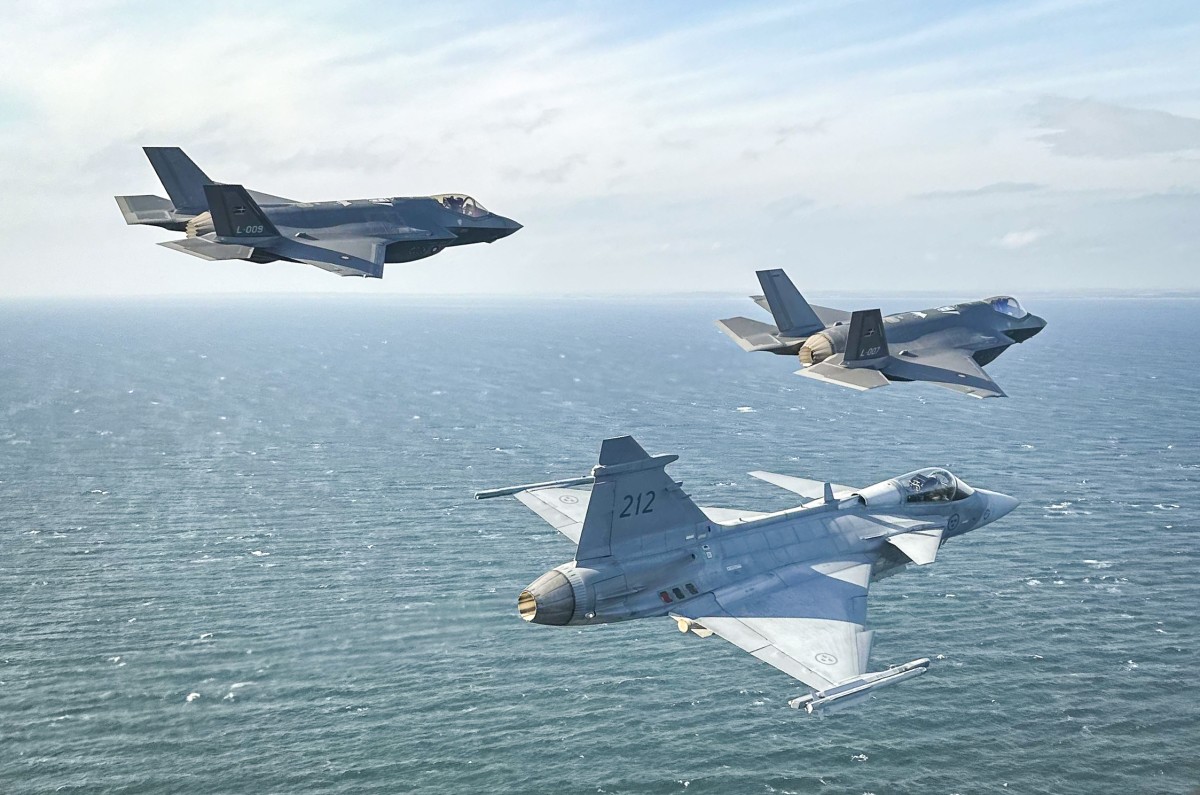Danish F-35 and Swedish JAS-39 Gripen fighter jets recently participated in simulated one-on-one air combat training exercises, marking the first such exercise between the two countries as NATO allies.
The training sessions on March 11 and 13 in and around Danish airspace showcased the growing military cooperation between Denmark and Sweden, emphasizing their commitment to joint operations.
The aerial drills, primarily conducted over the Kattegat waters, saw the Danish F-35s from Fighter Wing Skrydstrup and two JAS-39 Gripens from ‘Blekinge Flygflottilj’ at Ronneby near Karlskrona in southern Sweden engaging in one-to-one fighter maneuvers and coordinated flying.
In a statement released on March 15, NATO highlighted that the cooperation stems from a mutual interest between the two nations spanning across the Øresund, leveraging their respective experience and competencies to bolster combined air warfare capabilities.
Royal Danish Air Force Chief Major General Jan Dam said, “Being neighbors and close allies, utilizing each other’s capabilities not only provides great training value for pilots and personnel, but it is also visible proof of the ambition to operate effectively together.”
For the first time as #NATO Allies, 🇩🇰 F-35 & 🇸🇪 JAS-39 Gripen fighter jets flew aerial combat training drills in and around 🇩🇰 airspace
1 versus 1 air combat training – F-35 vs JAS-39 – Who do you think won this friendly battle?
Read more: https://t.co/GEotQUuH4U#WeAreNATO pic.twitter.com/2ioZElEeYg
— NATO Air Command (@NATO_AIRCOM) March 15, 2024
On the other hand, Lieutenant Colonel Erik Almquist, Commanding Officer of the Swedish Air Force’s 172 Fighter Squadron, highlighted the challenges and benefits of training with different aircraft types.
Almquist pointed out, “Carrying out this type of exercise flying with another type of aircraft provides different challenges and experiences than when it is normally practiced against our own units…… The biggest challenge has been whether to speak English or Danish/Swedish on the phone during briefing and debriefing.”
Moreover, the significance of these exercises extends beyond bilateral cooperation, emphasizing the necessity for existing and new combat aircraft fleets to cooperate effectively on the modern battlefield.
TRI, one of the Danish F-35 pilots, described the training as a professional challenge, stating, “We met our Swedish colleagues in Danish airspace to fly Basic Fighter Manoeuvres (BFM), also known as 1 versus 1 air combat training.”
“Most often, we fly BFM against our fellow F-35 pilots. The Gripen and Swedish pilots fly differently, so a one-versus-one match against them is a professional challenge. We get to test elements of our own tactics that we don’t normally do. It is awesome! And, of course, it’s great to meet the Swedes in Denmark,” TRI added.
F-35 Lightning Vs JAS 39 Gripen
In combat aviation, the Gripen and the F-35 represent distinct aircraft generations, each bringing unique strengths to the battlefield.
As a 5th-generation fighter, the F-35 is celebrated for its stealth capabilities. It was meticulously crafted to diminish its radar signature and bolster survivability in contested airspace.
In contrast, the Gripen, categorized as a 4.5-generation aircraft, incorporates some stealth features but falls short of the F-35’s prowess. Furthermore, the F-35 surpasses the Gripen in size, weight, payload capacity, and range, making it better suited for extended missions.
The F-35 fighter jet boasts a formidable weapons payload capacity ranging between 15,000 and 18,000 pounds, whereas the Gripen E, the latest iteration of the Gripen, maxes out at 14,330 pounds. In terms of range, the F-35 can traverse up to 1,380 miles, while the Gripen covers a distance of 810 miles.
Despite these disparities, the Gripen E carries six air-to-air missiles in standard configuration, similar to the F-35A. Yet, its significant edge lies in integrating the Meteor missile, widely regarded as superior to the AIM-120D in the F-35 arsenal.
Additionally, the Gripen holds a notable advantage in its capability to land on makeshift runways, such as ordinary highways, while the F-35A relies on airfields with more stringent operational standards.
Stefan Englund, a former Swedish Air Force Flight Engineer, earlier highlighted that the Gripen E can compete against the F-35. Englund noted that proponents of the F-35 often assert, “They will not even know what hit them.”

He argued that while the Gripen E retains the familiar appearance of its predecessor, it represents a major advancement with new features and capabilities.
Although the Gripen E lacks stealth technology, it boasts a lower radar cross-section (RCS) compared to any other fighter except the F-35 and F-22, potentially including Russian and Chinese stealth aircraft.
Englund also mentioned that the Gripen E would be equipped with a GaN (gallium nitride) based electronic warfare (EW) suite, which could enhance its stealthiness.
While these attributes undoubtedly enhance the appeal of the Gripen, what truly sets the F-35 fifth-generation aircraft apart is its extraordinary capability to gather and process vast amounts of data, which it can then share with allied forces and other stakeholders. This capability is unmatched by any other aircraft, placing the F-35 in a league of its own.
Nonetheless, the collaboration between the F-35 and Gripen in the latest aerial exercise amplifies their combined operational effectiveness. According to the Royal Danish Air Force, the F-35’s ability to generate and disseminate unmatched situational awareness also benefits the Gripen.
- Contact the author at ashishmichel(at)gmail.com
- Follow EurAsian Times on Google News